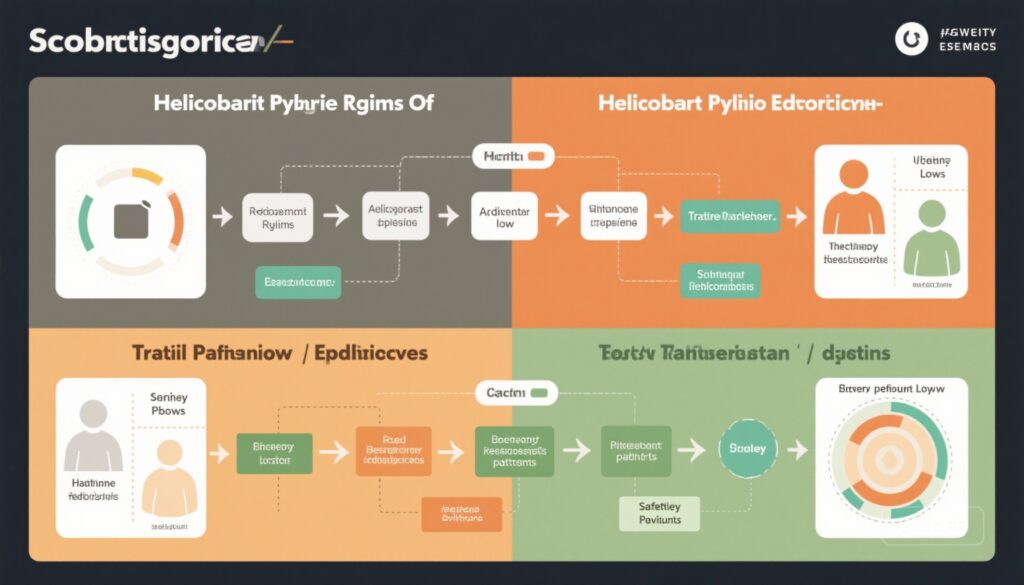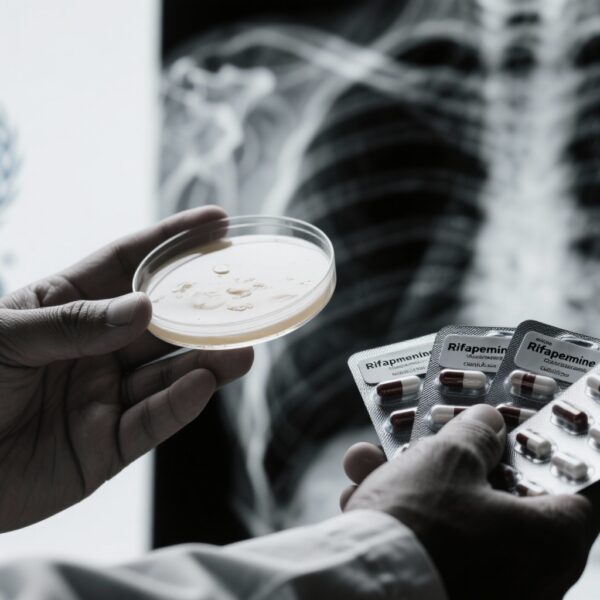Highlights
- Rifasutenizol (TNP-2198), a novel antimicrobial with dual mechanism, shows high efficacy against H. pylori, including resistant strains.
- In the EVEREST-HP phase 3 trial, rifasutenizol-based triple therapy (RTT) achieved a 92.0% eradication rate, non-inferior to bismuth plus clarithromycin-based triple therapy (BCTT) at 87.9%.
- RTT demonstrated a better safety and tolerability profile, with significantly fewer treatment-emergent adverse events, notably reduced taste perversion compared to BCTT.
- All cultured H. pylori isolates were susceptible to rifasutenizol, highlighting its potential role in overcoming clarithromycin resistance.
Background
Helicobacter pylori infection remains a global public health issue, associated with peptic ulcer disease, gastric cancer, and mucosa-associated lymphoid tissue lymphoma. In China, high prevalence of H. pylori and escalating antibiotic resistance rates—particularly to clarithromycin, metronidazole, and levofloxacin—complicate eradication strategies and diminish effectiveness of traditional regimens. Current first-line therapies, including bismuth quadruple regimens and clarithromycin-based triple therapy, show variable success, compromised by resistance and adverse events.
Rifasutenizol (TNP-2198) is an investigational antimicrobial with a unique synergistic dual mechanism targeting bacterial ribosomes and DNA, designed to retain activity against resistant H. pylori strains. Early-phase studies indicated promising efficacy and safety, necessitating robust evaluation in phase 3 trials to establish its clinical role.
Key Content
Phase 3 EVEREST-HP Trial Design
The EVEREST-HP was a randomized, multicentre, triple-dummy, double-blind, active-controlled, non-inferiority trial with an adaptive sample size design, conducted across 40 hospitals in China from May to November 2023 (ClinicalTrials.gov: NCT05857163). Eligible treatment-naive adults aged 18–65 years with confirmed H. pylori infection by positive [13C]urea breath test and histology were randomized 1:1 to receive either:
- RTT: rifasutenizol 400 mg, amoxicillin 1 g, rabeprazole 20 mg, twice daily for 14 days.
- BCTT: bismuth potassium citrate 240 mg, clarithromycin 500 mg, amoxicillin 1 g, rabeprazole 20 mg, twice daily for 14 days.
Randomization employed a secure interactive web system, stratified by site, with identical placebo tablets to maintain blinding.
Patient Population and Resistance Profiles
Of 1267 screened patients, 700 were randomized (353 RTT, 347 BCTT). The modified intention-to-treat population included 351 and 346 patients in the RTT and BCTT arms, respectively. Baseline characteristics were balanced; 63% female and 37% male.
H. pylori was cultured in 579 (83%) patients. Resistance was notable: clarithromycin (41%), metronidazole (68%), levofloxacin (35%), and amoxicillin (8%). Remarkably, all isolates were susceptible to rifasutenizol, underscoring its promise in resistant infections.
Primary Efficacy Outcome: H. pylori Eradication
Eradication was assessed by [13C]UBT at 4–6 weeks post-treatment. RTT achieved an eradication rate of 92.0% (95% CI 88.7–94.6) compared to 87.9% (95% CI 83.9–91.1) for BCTT. The absolute difference (4.2%, 95% CI –0.3 to 8.8) met criteria for non-inferiority with a −10% margin.
Safety and Tolerability
Treatment-emergent adverse events (TEAEs) occurred in 37% of RTT patients versus 53% in BCTT. Common TEAEs (>5%) in RTT were diarrhea (7%), nausea (6%), and dizziness (6%). In contrast, BCTT patients frequently experienced taste perversion (36%), nausea (6%), and diarrhea (5%). Most events were mild to moderate. There were no serious drug-related adverse events.
Contextualizing with Prior Evidence
Previous treatment regimens for H. pylori have been challenged by increased antimicrobial resistance. Clarithromycin resistance correlates with treatment failure rates exceeding 20–40% in many regions, including China. Bismuth-containing quadruple therapy and newer regimens incorporating novel agents have sought to improve efficacy. Rifasutenizol’s distinct dual mechanism—simultaneously inhibiting ribosomal function and DNA processes—provides a mechanistic rationale for efficacy against multi-drug resistant strains, as seen in vitro and now corroborated clinically.
Expert Commentary
The EVEREST-HP trial represents a high-quality, rigorously controlled evaluation of novel therapy in a real-world, high-resistance setting. The non-inferiority of rifasutenizol-based triple therapy signifies an important advancement, offering comparable if not superior eradication rates alongside a more favorable safety profile relative to the bismuth plus clarithromycin comparator.
The pronounced clarithromycin resistance in the cohort reflects contemporary epidemiology and underlines the limitations of clarithromycin-based regimens. Rifasutenizol’s susceptibility across isolates hints at its potential to circumvent resistance mechanisms that undermine conventional antibiotics.
Safety advantages—especially the markedly reduced incidence of taste perversion—may enhance patient adherence, a critical determinant of eradication success. The utilization of rabeprazole as proton pump inhibitor may also contribute positively to eradication rates.
Limitations include the regional focus on China; though the resistance patterns are globally relevant, external validation in diverse populations is warranted. Long-term follow-up data on resistance development and relapse are not yet available. Furthermore, economic and availability considerations for a novel agent will influence real-world applicability.
Conclusion
Rifasutenizol-based triple therapy emerges as a promising first-line option for H. pylori eradication in the context of increasing antimicrobial resistance, achieving high efficacy and improved tolerability compared with standard bismuth plus clarithromycin therapy. These data support rifasutenizol’s further clinical deployment and incorporation into updated treatment guidelines. Ongoing surveillance to monitor resistance trends and real-world effectiveness will be essential to fully establish its role in global H. pylori management.
References
- Song Z, Zhou L, Wang W, Lan C, Tang T, Xie J, et al.; EVEREST-HP Study Group. Rifasutenizol-based triple therapy versus bismuth plus clarithromycin-based triple therapy for first-line treatment of Helicobacter pylori infection in China (EVEREST-HP): a phase 3, multicentre, randomised, triple-dummy, double-blind, controlled, non-inferiority trial. Lancet Infect Dis. 2025 Sep 10:S1473-3099(25)00438-4. doi: 10.1016/S1473-3099(25)00438-4. Epub ahead of print. PMID: 40945526.
- Kwok CS, Mihaljevic AL, Kotzeva A, et al. Clarithromycin resistance and Helicobacter pylori eradication failure–a meta-analysis of randomized clinical trials. Aliment Pharmacol Ther. 2022;55(5):625-639. doi:10.1111/apt.16722
- Chey WD, Leontiadis GI, Howden CW, Moss SF. ACG Clinical Guideline: Treatment of Helicobacter pylori Infection. Am J Gastroenterol. 2017;112(2):212-239. doi:10.1038/ajg.2016.563
- Megraud F, Coenen S, Versporten A, et al. Helicobacter pylori resistance to antibiotics in Europe and its relationship to antibiotic consumption. Gut. 2013;62(1):34-42. doi:10.1136/gutjnl-2011-300630



